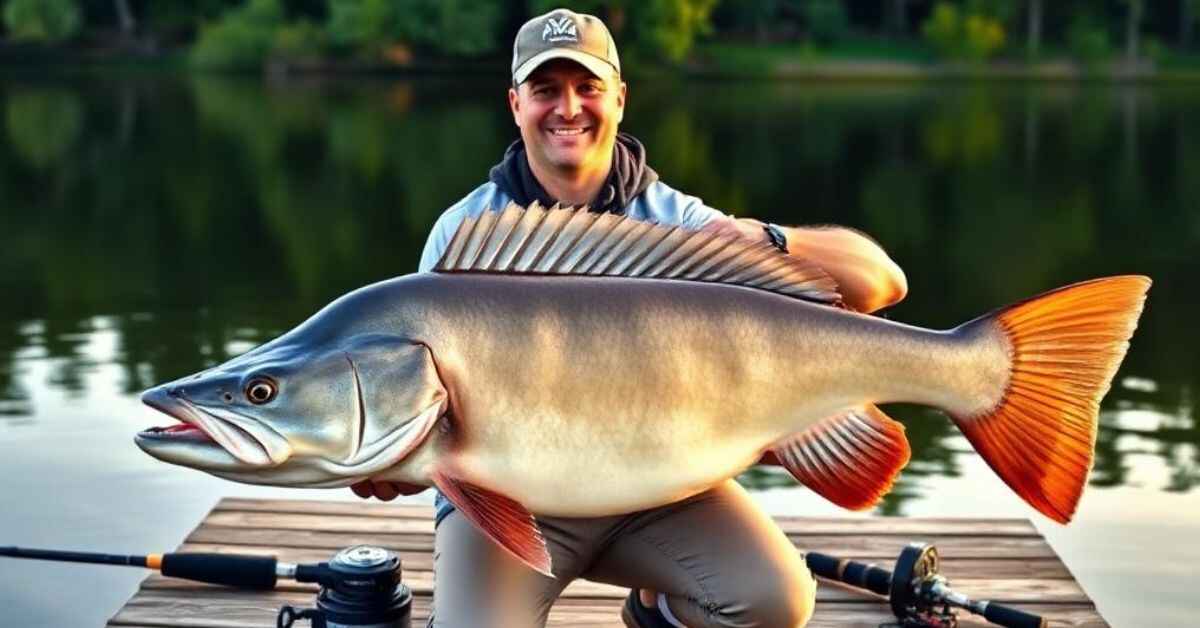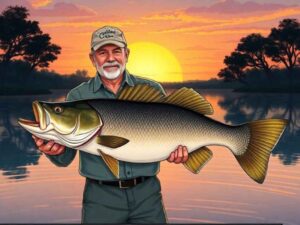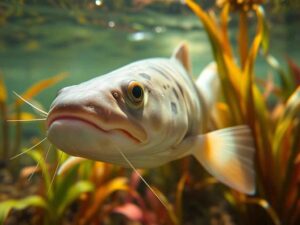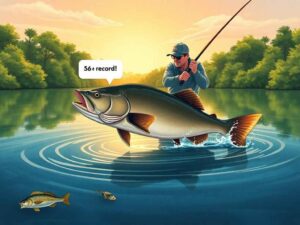Blue Springs, Langley, has a fantastic fishing history. A 56-pound catfish! This gigantic haul has shaken up the fishing community, but why is Blue Springs a haven for colossal catfish? We’ll start at the beginning and learn why it is one of the most popular destinations for anglers.
Introduction
Blue Springs, Langley, is an ideal fishing spot for its clear water and good fish. It became famous when an unprecedented 56-pound catfish was caught there, creating quite a stir among anglers. The size of this catch reveals how hungry the giant blue catfish can be in these waters. Do you know what a bigger catfish is? Blue Springs – Langley 56-pound catfish is one fishing legend!
Who is Langley?
Langley has made a name for himself as a fisherman after catching a 56-pound catfish at Blue Springs. This not only brought him fame but also brought a lot of anglers to the location in an attempt to set a new record.
What is Blue Springs?
Tracing its origin back to its geographic information system, Blue Springs is a fishing site popular for its clean water and intensive nature. As another catfish hotspot, it attracts fishermen from all over the United States. The location’s calm surroundings and excellent fishing conditions make it popular among the locals and tourists.
| Fun Fact Langley’s name is celebrated because of his incredible record at Blue Springs. His 56-pound catfish catch remains a benchmark that many anglers aspire to surpass even today |
What is Catfish?
Catfish are freshwater fish, each with a whisker-like barb at the mouth. They’re renowned for their size and appearance, and certain species, such as the blue catfish, reach staggering sizes. Catfish are found in rivers, lakes and streams and are prized by fishermen for their tough catch and flavor.
Blue Spring Make Langley 56 Pound Catfish Record
That 56-pound catfish from Blue Springs, Langley, has become a fishing classic.
The colossal fish was hooked by a seasoned angler, who had spent hours casting and waiting in the crystal clear waters of Blue Springs.
This catch not only established a new record for the region but also showed how big more catfish could be found in these waters.
The 56-pound blue catfish was a record-breaking fish and an amazing catch for fishermen.
Blue Springs has a reputation for its clean water, which is where catfish flourish.
The region’s rich, nutrients-laden waters feed a healthy ecosystem, and huge fish can survive.
This natural environment coupled with the right approach to fishing makes Blue Springs a mecca for big-game fishermen.
Whether it’s the stillness of the stream or the bounty of prey, Blue Springs remains a hot spot for catfish fishermen hoping to catch record fish.
Why Are Blue Springs So Famous For Fishing?
Blue Springs is known as one of Langley’s best catfish fishing spots.
These pristine, nutrient-laden waters are an ideal habitat for catfish. Because of its rich underwater life, fishermen frequently take enormous blue catfish here.
The calm stream current, plenty of prey, and fresh water makes Blue Springs the ultimate fishing destination especially for those who want to land a record fish.
Why Are Blue Springs So Good for Catfish?
Blue Springs water contains some of the nutrients that large fish. especially blue catfish, need to grow.
These nutrients fuel a successful food web that delivers enough to allow catfish to reach spectacular size.
The lack of pollution and stability of clear, oxygenated water are also factors that make Blue Springs the ideal site for these giant fish.
Fishing Regulations in Blue Springs
Before you pick up your rod and take off for Blue Springs, make sure to check out the fishing regulations.
These regulations were established in order to conserve the environment and to promote responsible fishing.
In many places, limits to how big, how many and what kind of fish are caught are regulated. Check with locals or guides for information about fishing rules at Blue Springs.
Catfishing Blue Springs Strategies and Techniques At Blue Springs
If you’re looking to catch giant catfish in Blue Springs, it pays to use the right tools. Many fishermen recommend live bait like shad or bluegill to capture larger fish.
These fish are attracted to the smell and motion of the bait, so they are apt to bite. Additionally, if you fish in the deeper waters in the morning or evening, you have a better chance of hooking a big one.
If you’re new to catfish fishing, it’s never a bad idea to consult local guides who know the waters well and can give you great tips on where to fish and how to fish them.
| “Want to catch a 56-pound giant catfish? Start planning your next fishing trip to Blue Springs today!” |
Would the Next Record-Making Catfish Be Yours?
Blue Springs is renowned for its big fish, but the 56-pound record remains vacant. Are you ready to crack this record? Head over to Blue Springs, and you could be the next big fish. Its clear waters, fishing knowledge and abundant wildlife leave the door open for even larger catfish. Why not try it?
What is the Heaviest Blue Catfish Ever Caught?
In the James River in Virginia, USA, the most powerful blue catfish ever documented was a 143-pound catfish.
This gigantic fish sets the record for the biggest blue catfish ever caught worldwide.
This record-breaking catfish weighs more than twice as much as Langley’s 56-pound catfish, so we know how great the blue catfish can grow in some places.
Langley’s 56-pound catfish might have been huge, but the James River’s 143-pound fish is a testament to how enormous the fish can become given the right conditions.
Habitat, diet and water quality are the most important factors affecting their size – all contributing to the expansion of these giant freshwater fish.
How Heavy Can a Blue Catfish Get?
A blue catfish will swell to impressive proportions, with some measuring more than 100 lbs.
Under ideal conditions, these massive fish can reach up to 140 pounds, making them one of the world’s largest freshwater fishes.
The size of a blue catfish is contingent upon many factors, including food, location and longevity. The diet of a blue catfish is crucial to its development.
They are opportunistic feeders, eating everything from small fish to crustaceans and even insects. They can reproduce rapidly and expand to larger sizes in the presence of abundant food.
Habitat is another key factor. Blue catfish flourish in arid rivers and lakes, supported by plentiful food and clear oxygenated water.
If the water is too full or unhealthy, it restricts their size because they can’t grow big enough. And lastly, how long a blue catfish survives matters. They can live up to 20 years or more, and the older they are, the bigger they get.
That means older blue catfish under ideal conditions can grow to truly enormous lengths, sometimes up to the same weight as that record-breaking specimen landed at Langley.
What is the Age of a 100 lb. Blue Catfish?
The average age of a 100-pound blue catfish will be 15 to 20 years old. Blue catfishes grow very fast, depending on the environment, but they grow rapidly during their early development.
Yet their growth slows as they age. A blue catfish grows, on average, 1–2 inches a year in the first few years of life, and a blue catfish can take 15–20 years to reach 100 pounds.
Scientifically, the age of a catfish is assessed by measuring the length of its otoliths (ear bones), which are ring-shaped like tree trunks.
By counting these rings, researchers can determine the age of the fish. Water temperature, food supply, and genes can all influence growth rates.
In the best of conditions, a blue catfish might mature faster, but in the worst, it will develop more slowly, taking longer to grow to 100 pounds.
What is the World’s Largest Catfish?
The world’s largest catfish is the Mekong giant catfish, which is the largest catfish in history.
This huge fish measures 10 feet long and weighs up to 646 lbs. It was killed in the Mekong River in Thailand, and thus is a true mammoth of a freshwater fish.
In terms of weight, the Mekong giant catfish is the largest caught catfish in the world.
But there are other giant catfish species too, such as the blue catfish or the Goonch catfish, which can become staggeringly large.
The blue catfish, for instance, has grown to more than 140 pounds, including a record catch in the James River in Virginia.
The Goonch catfish, found in the rivers of India and Nepal, is also capable of exceedingly large sizes – sometimes more than 200 lbs. though it’s not recognized as the biggest by any measure.
Although giant catfish are massive, these animals are typically endangered or protected, and populations can easily be wiped out through overfishing and habitat destruction.
Conclusion:
In conclusion, the Blue Springs Make Langley 56-pound catfish record stands as an exciting milestone in the world of fishing.
This remarkable catch not only showcases the incredible size of blue catfish but also highlights the potential that Blue Springs has for anglers seeking their own big catch.
Whether you’re an experienced fisherman or just starting, Blue Springs provides an ideal fishing location.
Is the next record-setting catfish yours? Go to Blue Springs and have a shot. maybe you’ll catch the next giant!
| Visit Blue Springs Today!
Is it your turn to become the next record-setting catfish? Time to get out and test your fishing prowess! Be sure to take your next fishing trip to Blue Springs and catch the biggest catfish you’ve ever seen. Whether you’re a seasoned angler or new to the sport, Blue Springs has just the place to catch that monster catfish. So book your trip now and get ready for the big catch! |
FAQs for the Article
Here are some common question mostly people want to know about Blue Springs Make Langley 56 Pound Catfish Record
Why is Blue Springs the Best Place to Catch Catfish?
Blue Springs’ clear, nutrient-laden waters are perfect for catfish to grow to staggering size.
Who Has The Largest Catfish In The World?
The record for the biggest catfish in the world is a Mekong giant catfish, which weighed more than 646 pounds and was caught in Thailand.
What Makes Catfish Big?
Catfish become big due to what they eat, the genes they have, and the space and food that exists within their environment.
Are There Catfish In Blue Springs?
Yes, Blue Springs is a fabled fishing destination for anglers interested in catching catfish of all sizes, including some record-breaking ones.
How Old Can Catfish Get?
Catfish are long-lived .some species can survive for up to 60 years, depending on the species and diet.
Are Man-Eating Catfish Real?
Although the phrase “man-eating catfish” is a bit of a fable, some species, such as the Goonch catfish, have had their own river legends.
What’s the Best Bait for Big Catfish?
Fish baits for large cats include live bait such as shad or bluegill, along with stink baits that are designed to catch cats by scent.









